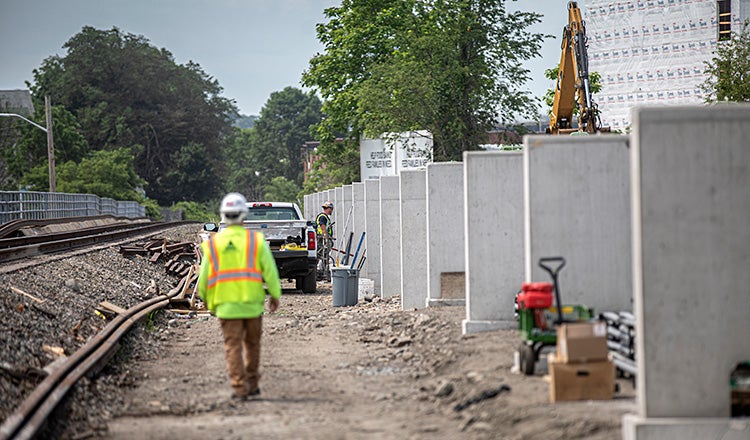South Coast Rail Program Management and Construction Management

South Coast Rail Program Management and Construction Management
Delivering a Major Commuter Rail Extension for Boston Travelers
The South Coast Rail project restored passenger rail service to southeastern Massachusetts for the first time in decades. The $1.1 billion Massachusetts Bay Transportation Authority project included the reconstruction of over 37 miles of railroad within active right of way and connected Boston to Taunton, Fall River and New Bedford.
In addition to new track, the project included the construction or reconstruction of 28 at-grade crossings, 14 bridges, 63 culverts, 6 commuter rail stations, 2 overnight layover facilities, and new signal and positive train control systems. All this infrastructure was designed and constructed in one of the most historic and densely populated areas of the United States.
As part of the program’s PM/CM team, HDR acted as an extension of the Massachusetts Bay Transportation Authority management staff, assisting the management of other consultants and contractors in support of the program. HDR provided services that included program implementation and general administration services, overall strategic implementation, program controls support, environmental permitting/coordination oversight, track and signal inspection and commissioning oversight, and public participation and stakeholder outreach.
We worked with the designer of record, the MBTA program team, and MBTA Railroad Operations so that the design and program oversight advanced cohesively through the life cycle of the program.
Systems Integration Expertise

The South Coast Rail program contained three separate line segments as part of the extension of existing Middleborough Line service. The Middleborough Secondary segment connects Middleborough to East Taunton; the New Bedford Mainline connects East Taunton to New Bedford; and the Fall River Secondary connects East Taunton to Fall River.
Systems integration on these three lines was a key challenge on the program, with the new commuter line being converted from existing unsignaled freight-only rail lines. Not only did the new systems need to be integrated with each other, but also into the MBTA’s existing operations and systems so the extension operated seamlessly when connected. This included interfacing with third parties such as Amtrak, whose dispatching system in Boston controls the new territory.
HDR’s design oversight team helped prevent current freight operations from being unduly impacted while also phasing in a continuously welded rail system that allows passenger trains to travel at much faster speeds. As a new shared track corridor, the line’s signal system needed to be able to handle both a slower, 100-car freight train and a faster passenger train with much fewer cars.
Our signal engineering experts, who have decades of railroad operations experience, oversaw the design, testing, and commissioning of the new signal and PTC systems. The signal system included multiple new interlockings, cab signal cut-sections and grade crossings with automatic warning devices to add operational capacity and resiliency. The PTC system included multiple wayside components and back-office server updates to enhance the safety of the operation. Work on the PTC system, being a relatively new technology and Federal Railroad Administration requirement, required a proactive approach to coordinate the technical needs of the system and its integration with the program’s contractor.
Independent Design Reviews and Extensive Construction Oversight
Our project controls work allowed the MBTA to easily monitor the ongoing health of the complex program, with information on different projects and phases tracked in an intuitive dashboard. This real-time reporting included project financials and schedules, combined with detailed information and uploaded photos or field updates from project staff.
As the team in charge of reviewing designs, our reviewers provided wide expertise, assessing designs for conformance to MBTA standards, constructability, accessibility, cost-effectiveness, environmental compliance and conformity with local, state and federal codes. We performed an independent cost estimate and schedule to validate the overall program cost. This led us to provide key input to repackage the program into 10 construction contracts to improve the schedule. Our team worked hand in hand with MBTA throughout the program to manage the budget and negotiate change orders on these projects.
During construction, we provided field oversight for several construction activities, with an emphasis on track and signal inspection. Our staff oversaw installation of new track and special trackwork, and all contractor signal and PTC commissioning activities in the field, including coordinating test trains with the operating railroads over the course of seven months of commissioning the signal and PTC systems.
HDR further oversaw the contractor’s performance of all system integration and configuration management activities during the testing and commissioning of both the signal and PTC systems. During this period, the team kept the contractor on task with daily progress meetings and review of any issues discovered. We provided sequence and mitigation alternatives to maintain the project schedule while issues discovered during commissioning were resolved.
All of this work culminated in the opening of South Coast Rail Phase I to revenue service on March 24, 2025.









